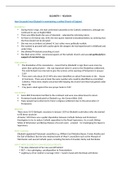Class notes
AQA A level History Notes - The Tudor Dynasty: Elizabeth I
- Course
- Institution
- Book
AQA A level History Notes on The Tudor Dynasty: Elizabeth I. Notes include all topics under the Elizabeth I part of the course. Topics included are: - Elizabeth I Religion - Elizabeth I Government & Parliament - Elizabeth I Foreign Policy - Elizabeth I Society, Economy and Culture - Elizab...
[Show more]




